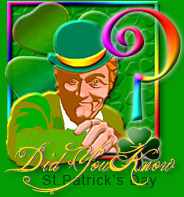Did You Know? Facts, Figures & Folklore about St. Patrick’s Day
Did you know that St. Patrick’s Day is the Roman Catholic feast honoring Ireland’s patron saint, St.  Patrick? Theholiday is also an international celebration of Irish history and heritage.
Patrick? Theholiday is also an international celebration of Irish history and heritage.
Did you know that Patrick was neither Irish nor particularly religious, at least not initially? Patrick was born Maewyn Succat in 385 CE in the Welsh town of Banwen, and for the first sixteen years of his life he was an avowed pagan.
Did you know that Patrick, nee Maewyn, was captured by Gaelic slave traders at the age of sixteen and sold to an Irish sheep farmer? Patrick was enslaved for six years, during which he turned to Christianity for comfort. He escaped at the age of 22, and spent the next 12 years living in a British monastery. It was there that he adopted the name Patrick.
Did you knowthat Patrick returned to Ireland after his time in a monastery, along with 20-some followers, serving as a Christian missionary?
Did you knowthat St. Patrick is believed to have died in Ireland on March 17, 461 C.E.? The anniversary of his death is now the day on which St. Patrick’s Day feast is celebrated.
Did you know that the myth that Saint Patrick drove all the snakes from Ireland into the Irish Sea is just that — a myth? Many locals still insist that the serpents were drowned in the Irish Sea by Saint Patrick, causing their seas to be so rough. The truth, however, is that serpents where never native to Ireland. The story is most likely a metaphor for the druidic religions, which disappeared from the Emerald Island after St. Patrick spread the seeds of Christianity.
Did you know that St. Patrick’s Day is a national holiday in Ireland? It is also a provincial holiday in Newfoundland and Labrador, both Canadian provinces with significant Irish populations.
Did you know that there are 34 million U.S. citizens claiming Irish ancestry? That’s nearly ten times the population of Ireland today, which has 3.9 million people. Since 1820, 4.8 million Irish have legally immigrated to the U.S.
Did you know that Irish Americans are the second most numerous ethnic group in the United States? Only four other countries (Germany, Italy, Mexico and the United Kingdom) have sent more native-born residents to U.S. shores.
Did you know that while it is customary to wear green on St. Patrick’s Day in the United States, the color green is actually considered unlucky in Ireland? Green is the color of faeries, which are believed to steal children who wear too much green.
Did you know that the Irish celebrate St. Patrick’s Day by wearing shamrocks on their lapels’ and dressing their children up in the colors of the Irish flag: orange, white and green? The green on the flag symbolizes the people of the south, the orange represents the people of the north. The white stands for peace, which brings the green and orange together as a united nation.
Did you know that the first St. Patrick’s Day parade was held in Boston, Massachusetts? The parade has been an annual tradition since 1737.
Did you know that the first St. Patrick’s Day parade in New York was held in 1762? Irish immigrants serving in the British colonial army marched down the streets.
Did you know that the New York St. Patrick’s Day was officially launched in 1850? Today, this parade is the longest running civilian parade in the world, with 150,00 participants and nearly three million live spectators.
Did you know that the largest St. Patrick’s Day parade in Canada is held in Montreal? The parade began in 1824.
Did you know that Chicagoans celebrate St. Patrick’s Day by dyeing the Chicago River green? The tradition started in 1962. Today, 40 tons of dye is used, which keeps the river green for several hours.
Did you know that Guinness, the most famous of Irish dark stouts, was first brewed in Dublin Ireland in 1759? More than 1.9 billion pints of Guinness are drank around the world every year.
Did you know that Dublin is the capital of Ireland? There is also a Dublin in California and another Dublin in Ohio.
Did you know that the shamrock, considered the official plant of Ireland, was viewed as a sacred plant in ancient Ireland? The shamrock symbolized rebirth.
Did you know that in the seventeenth century, the shamrock became a symbol of Irish nationalism? In defending themselves against encroaching English imperialism, many Irish wore a shamrock on their lapel as a symbol of their opposition to English rule.
Did you know that leprechauns are traditional Irish folk figures? Leprechauns are believed to be cranky little fellows responsible for mending the shoes of fairies and causing all sorts of mayhem and mischief.
Source: National Geographic News, Kaboose.com, and History.com



